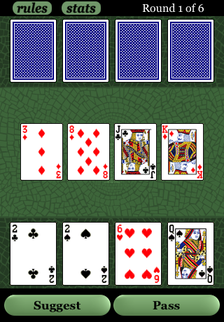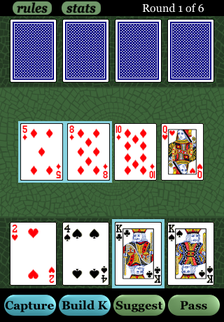Cassino Strategy
We’ve put together some ideas here about how to win more often at Cassino.
To determine the best play in complicated cases, you need to know something about probabilities, which we will talk about below. However, you can often make a good choice just by thinking about the plays your opponent (the computer) might make. For example, let’s say the only plays you can make are trails. What should you do?
Your goal is to capture as many cards as possible, and for this reason you might tend to think offensively. That is, you try to play so that you’ll be able to capture cards later in the round. But a situation that is set up to maximize your captures is often a good situation for the computer to capture a lot of cards too. So you need to learn to think defensively as well.
For example, suppose you are in the situation illustrated in Figure 1. It is the first round, no cards have been played. You can’t capture or build anything, so you have to trail. You have a few low cards and one high card, and your natural instinct is to hold onto your high card, because it is more likely to be able to capture cards later on in the round than will a low card. So you decide to trail your two. Is this a good play?

Figure 1
Trailing Choices
Well, the two can be combined with cards on the table to make a lot of different card combinations. Let’s list them.
• With the three to make 5.
• With the eight to make 10.
• With the three and eight to make king (13).
• With the jack to make king (13).
Note that there is one card on the table that can’t be combined with the two: the king. Small cards can be combined with lots of other cards, high cards can’t. So when you decide to trail a small card in order to hang onto your high cards, this increases your probability of making a capture later on only if the computer doesn’t capture lots of the cards on the table first!
In this particular case, it would be shocking if the computer could not capture something with 4 cards in its hand and a table consisting of a two, three, eight, jack, and king.
When the computer has only 1 or 2 cards in its hand, the situation is different. There are far fewer possible captures remaining, so it becomes much safer to trail a low card then than it is in the first few plays of a round.
What this means is that in the initial plays to a round, it is generally better to trail higher cards, especially if there are already several cards on the table. It’s a safer, more defensive play, even though you give up some of your offensive capabilities. But as cards are played to a round, it becomes safer to trail lower cards, holding on to your offensive firepower. In the beginning of a round, all other things being equal, we suggest you trail middle-valued cards (between sevens and jacks, say), and then trail lower valued cards as the round progresses.
We now turn to more complicated cases, where you need some idea about the probabilities of various card combinations. Let’s start out with a simple example. Suppose that Figure 2 is the initial deal of a game.

Figure 2
Capture or Build
You could capture the five and the eight on the table with one of your kings, or you could build kings (13) with one king and the five and the eight, then capture that build later with the other king in your hand. Which should you do?
The only way the build can go wrong is if your opponent has a king. To determine what to do, you’d like to know the probability that he has one. It’s fairly hard to determine this in general, because the probabilities change as cards are played. But at the beginning of the game, when no plays have been made yet, there are just a few probabilities to know. Furthermore, even knowing them approximately is good enough.
Here is a good rule of thumb:
At the beginning, the probability that your opponent has at least one of a particular card is 9% for each of those cards you can’t see.
This is just an approximation, but it’s close enough for making good plays. The reason for it is simple: at the beginning of the game your opponent is holding 4/44, or around 9%, of the unseen cards.
Using this rule, let’s consider kings. We see two kings, which means there are two kings we can’t see. Therefore the probability that the opponent has at least one king is 2 × 9%, or 18%.
Just to make sure you understand this, what’s the probability that the opponent has at least one nine? Well, we don’t see any nines, which means there are four unaccounted for, which means the probability that the opponent has at least one is 4 × 9%, or 36%, about one-third.
Okay, back to the kings. The probability is about 18%. Let’s round that up to 20% for easy arithmetic (we have more calculating to do), and try to figure out whether it would be better to capture or build.
The answer involves computing the expected value, the number of points you would win on average if you made the same play in a lot of Cassino games. You compute the expected value of a play by multiplying the score you would get if the play is successful by the probability of success. Then you subtract the similarly computed value for when the play fails. Let’s work through the kings example; it will illustrate the idea.
An immediate capture has a value of 3 points, and the probability you get those points is 100% if you do the capture right away, which means the expected value is 3. There is no possibility of failure in this case.
If you build and capture later, you get 4 points. But there’s some chance that if you try to do that, the computer will capture your build before you can. And it will do that if it has a king in its hand. We already know the computer has about a 20% chance of having one of the missing kings. This means you have an 80% chance of getting 4 points (an expected value of 3.2) and a 20% chance of losing 3 points to the computer if it steals your build (an expected value of negative 0.6). So the expected value of the build is 3.2 − 0.6, or 2.6. And that’s less than 3. Our rough calculation shows that the best play is to capture right away.
We have to add this: the immediate capture is even better than that, because if you capture immediately, you are still left with a king in your hand. A high card like a king is a powerful offensive card, very useful to have in your hand during later plays in a round, as we talked about already. So you should definitely capture in this situation.
(By the way, this kind of calculation is an application of basic probability theory. If it’s new to you, you may want to check it out.)
It’s very useful to make this calculation to get a feel for the tradeoffs among different plays. But you don’t have to make this kind of calculation for every play. In fact, unless you keep track of the cards as they are played, you won’t know the probabilities you need for the computation. The 9% rule is only good at the very beginning of a game. After cards have been played, the probabilities change.
Here is a simple example of probabilities later in the game. Suppose it is the last round, you have two kings in your hand, and no kings are on the table. What is the probability your opponent has a king? Well, if the other two kings were played in earlier rounds, the probability is 0%. But if at least one of them hasn’t been played, the probability is 100%! So to know the probability, you have to know how many kings have been played so far.
Only really serious Cassino players will track all the cards that have been played in a game. But you can come up with a rough rule based on the calculation for the beginning of the game. In the early rounds you should build only if you get more than 1 extra point, and capture immediately otherwise. After a few rounds have been played, you could factor in how many cards are outstanding and be willing to make a few more builds.
If you want to get more serious, it’s not so hard to keep track of some of the cards that have been played. A good initial goal is to keep track of the face cards and aces. It’s fairly easy after a bit of practice. And it can come in really handy when choosing between captures and builds at the end of the game.
Keep in mind that the computer is fantastic at keeping track of cards and probabilities. It always knows exactly what cards have been played. It has no difficulty computing the expected value for every possible play. Luckily, it has weaknesses that more than compensate for this. It can’t think too far ahead in the game (as the calculations start to become too slow). It doesn’t try to guess your cards based on the plays you choose to make. These are things that come naturally to people, but are difficult for a computer (at least in the current version of Cassino!).
If you work at it, you have a chance of beating the computer. Not all the time, but plenty of the time.
Good luck!


